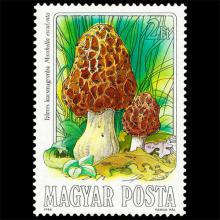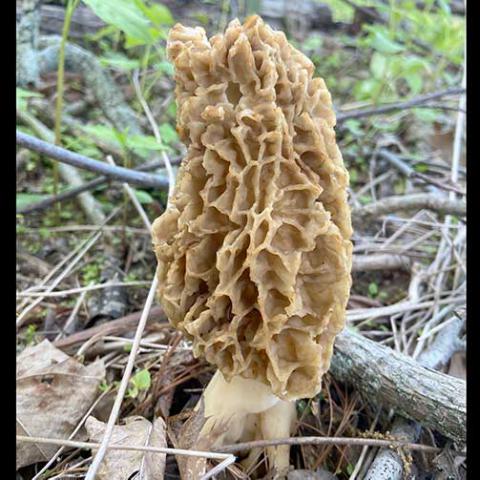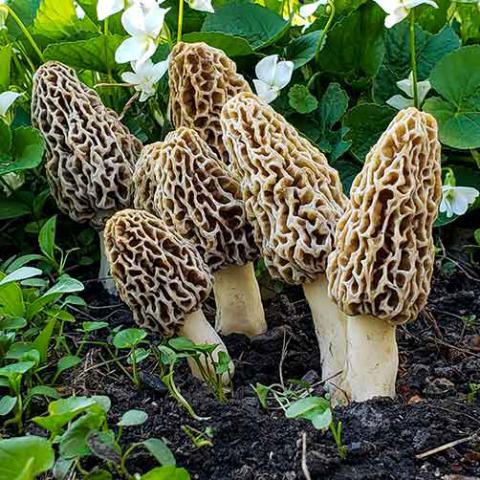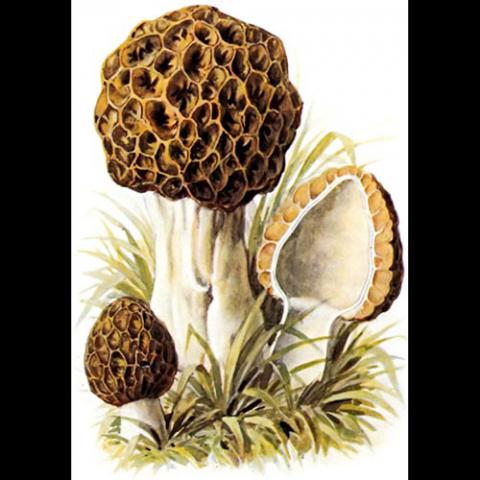NAMES
TAXONOMY
FUNGI ID
THERAPEUTIC
Hungary
Issued:
Stamp:
Morchella esculenta
Hungary
Issued:
Stamp:
Morchella esculenta
Hungary
Issued:
Stamp:
Morchella esculenta
Genus species (Fungi): Morchella esculenta
Morchella esculenta, (commonly known as common morel, morel, yellow morel, true morel, morel mushroom, and sponge morel) is a species of fungus in the family Morchellaceae of the Ascomycota. It is one of the most readily recognized of all the edible mushrooms and highly sought after. Each fruit body begins as a tightly compressed, grayish sponge with lighter ridges, and expands to form a large yellowish sponge with large pits and ridges raised on a large white stem. The pitted yellow-brown caps measure 2–7 cm (1–3 inches) broad by 2–10 cm (1–4 in) tall, and are fused to the stem at its lower margin, forming a continuous hollow. The pits are rounded and irregularly arranged. The hollow stem is typically 2–9 cm (1–3+1⁄2 in) long by 2–5 cm (1–2 in) thick, and white to yellow. The fungus fruits under hardwoods and conifers during a short period in the spring, depending on the weather, and is also associated with old orchards, woods and disturbed grounds
Taxonomy and naming
The fungus was originally named Phallus esculentus by Carl Linnaeus in his Species Plantarum (1753), and given its current name by Swedish mycologist Elias Magnus Fries in 1801.
Morchella esculenta is commonly known by various names: morel, common morel, true morel, morel mushroom, yellow morel, sponge morel, Molly Moocher, haystack, and dryland fish. In Nepal it is known as Guchi chyau. The specific epithet is derived from the Latin esculenta, meaning "edible".
The scientific name Morchella esculenta has been applied to many similar yellow morels throughout the world. In 2014 Richard et al. used DNA analysis to restrict the M. esculenta name to a single species of yellow morel commonly found in Europe and also reported from China. Other species of yellow morel, including those in North America, have received new scientific names.
Description
The cap is pale brownish cream, yellow to tan or pale brown to grayish brown. The edges of the ridges are usually lighter than the pits, and somewhat oval in outline, sometimes bluntly cone-shaped with a rounded top or more elongate. Caps are hollow, attached to the stem at the lower edge, and typically about 2–7 cm (1–3 in) broad by 2–10 cm (1–4 in) tall. The flesh is brittle. The stem is white to pallid or pale yellow, hollow, and straight or with a club-shaped or bulbous base. It is finely granular overall, somewhat ridged, generally about 2–9 cm (1–3+1⁄2 in) long by 2–5 cm (1–2 in) thick. In age it may have brownish stains near the base. It has a passing resemblance to the common stinkhorn (Phallus impudicus), for which it is sometimes mistaken. Yellow morels are often found near wooded areas. Centipedes sometimes make their home inside these morels; infested morels usually have a hole in the top.
Habitat and distribution
Fruit bodies are sometimes solitary, but more often in groups, on the ground in a variety of habitats. A preference for soil with a limestone base (alkaline) has been noted, but they have also been found in acid soils. The mushroom is usually found in early spring, in forests, orchards, yards, gardens and sometimes in recently burned areas. In North America, it is sometimes referred to as the "May mushroom" due to its consistent fruiting in that month, but the time of fruiting varies locally, from February to July. It is typically the last morel species to fruit in locales where more than one species are found. For example, in northern Canada and in cooler mountainous regions, morels typically do not appear until June. It has been suggested that the springtime fruiting may be due to their ability to grow at low temperatures to the exclusion of competition, a conclusion later corroborated by experiments correlating spore germination to soil temperatures.
One author suggests the acronym PETSBASH may be used to remember the trees associated with morels: pine, elm, tulip, sassafras, beech, ash, sycamore, and hickory.
In North America, it is widely distributed, but especially common in eastern North America and the Midwest. David Arora notes that "large crops can also be found around the bases of dying (but not quite dead) elms attacked by Dutch elm disease." The species has been named state mushroom of Minnesota, and was the first state mushroom of any state.
It can also be found in Brazil and Bulgaria. In Jammu and Kashmir wild mushrooms, locally known as Himalayan wild mushroom, Gucchi, Morchella conica and Morchella esculenta, are gathered and supplied as medical remedy./p>
Edibility
Morchella esculenta, like all morels, are among the most highly prized of all edible mushrooms. Raw morels have a gastrointestinal irritant, hydrazine, but parboiling or blanching before consumption will remove it. Old fruit bodies that show signs of decay may be poisonous. The mushrooms may be fried in butter or baked after being stuffed with meats and vegetables. The mushrooms may also be dried by threading the caps onto string and hanging them in the sun; this process is said to concentrate the flavor. One study determined the main nutritional components to be as follows (on a dry weight basis): protein 32.7%, fat 2.0%, fiber 17.6%, ash 9.7%, and carbohydrates 38.0%.
In one isolated case in Germany, six people were reported to have developed neurologic effects between 6–12 hours after consumption. The effects included ataxia and visual disturbances, and lasted up to a day before disappearing without enduring effects.




